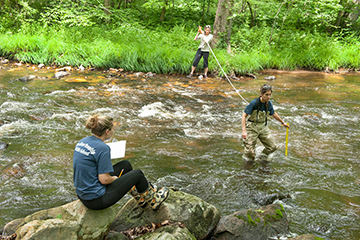 RHA Report: Stream Health in the North and South Branch Raritan Watershed (WMA8), New Jersey, USA, 1992-2017, Part 1: Temporal Trends and Regional Patterns in Benthic Macroinvertebrate Community Metrics
RHA Report: Stream Health in the North and South Branch Raritan Watershed (WMA8), New Jersey, USA, 1992-2017, Part 1: Temporal Trends and Regional Patterns in Benthic Macroinvertebrate Community Metrics
Over several decades, Raritan Headwaters Association (RHA) has been a leader in the state, conducting annual biological, chemical, and habitat monitoring at longterm sites throughout the North and South Branch Raritan River Region (WMA8) through its award-winning stream monitoring program. Monitoring has included collection of high quality data using NJ Department of Environmental Protection (NJDEP) protocols for collecting data on benthic macroinvertebrate communities of streams and rivers over several decades allowing for the analysis of trends in water quality with time and exploration of patterns by watershed region. RHA scientists along with trained citizen scientists work together each year to visit monitoring sites in streams throughout the watershed (click here to look up monitoring sites near you).
Benthic macroinvertebrates, including insects, crustaceans, worms, and mollusks, are used as indicators of water quality because taxa vary in their tolerance of pollution and the presence of sensitive species such as mayflies, stoneflies and caddisflies (EPT species) indicates clean, oxygen-rich, cold water. The High Gradient Macroinvertebrate Index (HGMI) and New Jersey Impairment Score (NJIS) are two indices calculated from benthic macroinvertebrate data used in New Jersey to measure water quality and ecological health of streams.
Temporal trends and geographic patterns were explored using RHA’s data on benthic macroinvertebrates collected from 105 monitoring sites for two long-term periods (1992-2017 and 2000-2017), and 4 shorter time-periods in between, for the watershed overall and combinations of major river (North Branch vs. South Branch) and physiographic province/region (Highlands vs. Piedmont) using Spearman Rank correlation. In addition, relationships of macroinvertebrate metrics to local habitat, chemical, and land use-land cover parameters were explored.
Summary of Findings:
- A total of 3,608 Spearman Rank correlation analyses of time with 15 macroinvertebrate community metrics were run using site-level data and results were tallied. Most of the sites (83% and 89%, respectively) did not exhibit significant trends in HGMI during the 2 longterm periods, 1992-2017 and 2002-2017. Most (89%) of the sites included in the recent, short-term analysis did not exhibit a trend in HGMI over time.
- Macroinvertebrate metrics were categorized based on whether they are indicating improvements to water quality (positive impact trends) versus trends indicating declines in water quality (negative impact trends), There were slightly more longterm and recent positive impact trends for sites than negative impact trends. Two hundred sixty-five (7%) positive and 145 (4%) negative trends were detected, (P<0.05). When community parameters were categorized based on whether they are indicators of improving or declining water quality, 232 trends (6%) indicated an impact of improved water quality whereas 178 (5%) indicated a decline in water quality (p<0.05).
- When all macroinvertebrate metrics were tallied for trends indicating improvements to water quality (positive impact trends) versus trends indicating declines in water quality (negative impact trends), the longterm pattern was different than what was detected in recent years (2010-2017). Longterm, 19% of the sites had >1 parameter indicating
declines in water quality while 29% of the sites had >1 parameter indicating an improvement in water quality. Whereas in recent years, 26% of the sites had >1 indicator of a decline in water quality while 18% had >1 indicator of improvements. - There has been a trend of increasing proportion of impaired sites watershed-wide since about 2010. This trend is most pronounced in the North Branch, especially in the Highlands region but also in the Piedmont. The South Branch also demonstrated recent increases in the amount of impaired sites but in 2017 the number dropped drastically in both the Highlands and Piedmont.
- Over the longterm, there was a pronounced decline in HGMI and NJIS in the North Branch-Highlands and NJIS in the South Branch-Highlands. In recent years, the North Branch-Highlands also had a trend of declining HGMI and NJIS and declining HGMI in the South Branch-Piedmont.
- Negative water quality impact trends included increases in pollution-tolerant taxa and non-insect taxa, and decreases in sensitive EPT taxa.
- HGMI was positively correlated with dissolved oxygen, stream depth, number of stream depth-velocity regimes, epifaunal substrate, % forest cover, % open water and % barren land in the catchement and negatively correlated with temperature and embeddedness.
- NJIS was positively correlated with % open water in the catchement and stream depth and negatively correlated with % urban land use.
This study identifies specific sites and regions where preservation of forest and/or restoration should be targeted. Sites that have shown improvement or have not changed need protection. Sites that have declined likely require restoration. Preliminary analysis shows that both local stream conditions as well as catchment-level land use are impacting the benthic macroinvertebrate community.
The RHA stream data will be analyzed for more specific trends and patterns in benthic macroinvertebrate community composition; climate change and severe weather impacts; and local and landscape-scale factors influencing stream health. These analyses will be presented in subsequent Raritan Headwaters Working Papers.
